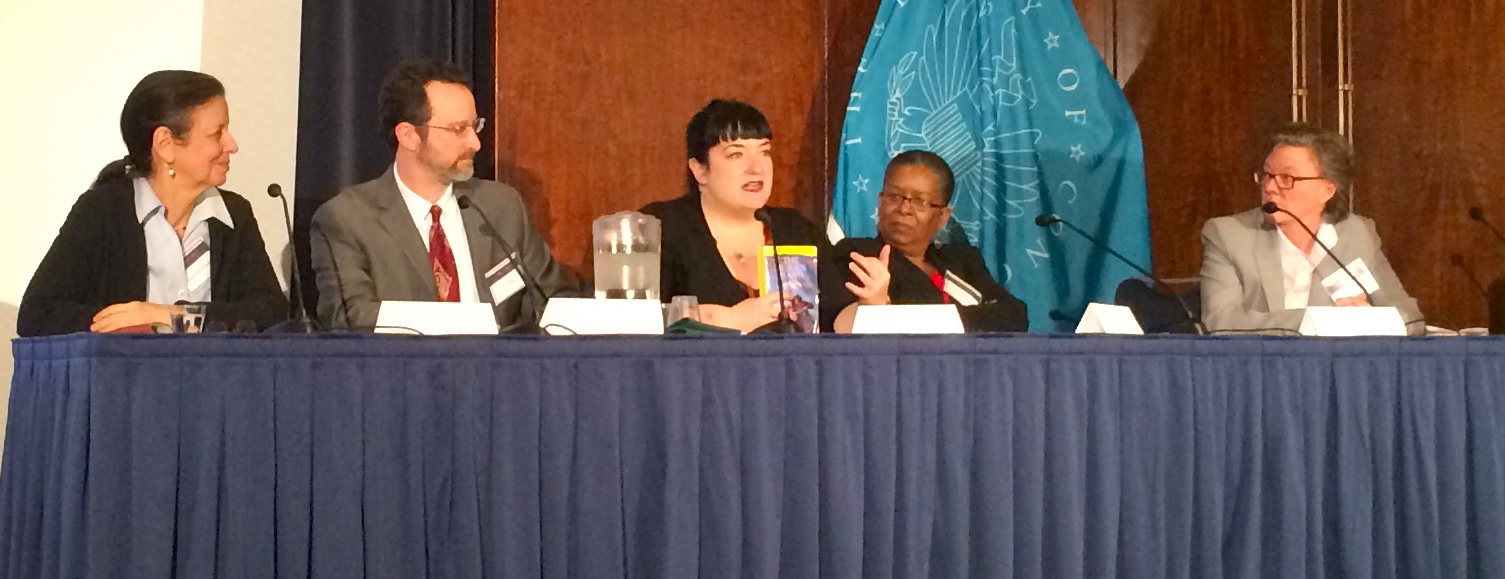I was pleased to see that romance author Diane Gaston felt that Laurie Kahn's documentary is "the most respectful depiction of the romance genre that I’ve ever seen." The conference at the Library of Congress was clearly a very positive and thought-provoking experience for many attendees. Eric posted the following note to the Romance Scholar listserve:
At the recent Library of Congress symposium some questions came up about the history of African American popular romance fiction, and after the conference, Kathleen Gilles Seidel passed along a memory that Pam Regis thought worth getting out into the record: a “footnote,” as she called it, to the history that’s been discussed elsewhere.
In 1982 when Vivian Stephens, an African-American, was the editor in charge of putting together the new Harlequin American line, she really wanted to feature an book with African-American characters. She didn’t get an appropriate submission. So she asked Jackie Weger, a Southern white writer, to take the characters in her book A Strong and Tender Thread and make them black. Jackie did so, and Vivien intended to make it one of the four launch titles.
During test marketing, the book tested horribly so Harlequin assumed that readers didn’t want books with black characters . . . as opposed to assuming that readers don’t want fake books with black characters. So the book was taken out of the first month (and my book was put in – which is why I remember this story so well as it worked out beautifully for me). It was published in 1983 as Harlequin American Romance #7 during the second month of the series. It did have very light-skinned African Americans on the cover, and it was the first series romance featuring African Americans released by Harlequin (and possibly any series publisher). But they didn’t put their best foot forward.
Personally, I suspect there was indeed a big problem with White "readers [who] didn’t want books with black characters" because, not much later, Harlequin published a romance by a Black author, with Black characters:
Sandra Kitt of New York had written her first Harlequin with black characters in 1984, but after Adam and Eva, "I couldn't get them to accept the other black novels. They said they didn't know anything about the market," she told the Boston Globe. In fact, Harlequin got scads of letters complaining about the book, including one from a Philadelphia woman who said, "Those people should have their own series." (Grescoe 279)Harlequin was a business and it sounds to me as though their market-research and consumer feedback was telling them loudly, and often in an explicitly racist manner, that romances featuring Black characters didn't appeal to their existing readers and therefore wouldn't sell well.
On the topic of romance as a business, Bobbi Dumas mentions at Kirkus that "Laurie Kahn [...] refers to it as 'a female-powered engine of commerce, a multi-billion dollar business and tech-savvy global sisterhood'" and Elisabeth Lane writes that
a common thread that struck me after watching the documentary film and after attending the conference the next day: the huge economic impact of the romance genre. As a romance reviewer, I typically think of romance in terms of its content: stories, characters, plots, themes. And sometimes in terms of sociological analyses of what we as a society say about the romance genre and what the romance genre says about us. But while I have always known intellectually that romance is a huge business (it’s a fact that gets repeated frequently by romance apologists), I hadn’t really considered its impact on individual women’s finances. During the film and the conference, the theme that romance is a genre “for women, by women, and about women” was repeated at least a half dozen times by various speakers. While in the spirit of inclusiveness, we know that’s not always the case, it is still very much true of the bulk of the romance industry. Not only is the romance industry in general for women, by women, and about women, it is also a business that accrues major economic benefit to women.You can read more of Lane's thoughts about "Financial Empowerment from Romance" here.
Anne Bornschein, meanwhile, spent some time mulling over comments made by "William Reddy, Professor of History and Cultural Anthropology at Duke, who asserted that contrary to popular belief, modern romance novels do not represent archetypal models of love." She concludes that
although the definition of romantic love that guides popular romance fiction today is not transhistorical, the premodern Western literary tradition has a lot to offer scholars and readers of popular romance in terms of productive lenses through which to view current literary trends.And the rest of her thoughts on the topic can be found here.
Here are some areas of correspondence between the premodern and the (post)modern that readily come to mind:
- alternative models of love, in particular possible slippage from the homosocial bond (i.e., bromance) to the homosexual, including iconic male couples such as Roland and Olivier, or Lancelot and Galehaut, as antecedents to today’s m/m romance
- narratives foregrounding cross-dressing, role reversal, and gender performativity in texts such as Aucassin et Nicolette and Le Roman de Silence
- Marie de France’s Lais such as Yonec and Bisclavret as medieval forebears to the were- and shapeshifter trends in romance, and more broadly, the medieval Otherworld’s link to fantasy-inflected love stories
- authorship and readerly community in the Middle Ages: Arthuriana as a medieval form of fanfic in which vast networks of writers contributed translations, reworkings, alternate continuities, continuations, prequels, and paratexts
- hagiography (saints’ lives) as a parallel genre associated with discourses of passion (both physical and spiritual), sacrifice, and bodily suffering, with particular emphasis on metaphor
----
Grescoe, Paul. The Merchants of Venus: Inside Harlequin and the Empire of Romance. Vancouver: Raincoast, 1996.


